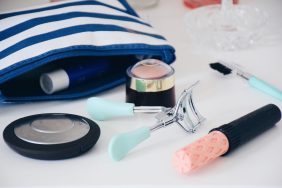Finding the right foundation shade is the key to faking #FlawlessSkin. Understanding your undertone — cool, warm or neutral — is the real difference between your makeup looking natural or too contrived. But fret not, identifying your skin tone (and looking your best) doesn’t have to be stressful. Read on for a few expert tips to help you find your undertone.
Take Your Time
As tempting as it is to breeze through the drugstore or department store aisles, slow your roll. “Shade is most important — your foundation has to be matched properly,” says celebrity makeup artist Ashunta Sheriff. Test out a few shades to find the one that seamlessly blends into your skin. “If a makeup is too light, you will look ashy or as if you have a gray tone. If it’s too dark, you will look muddy. Of course, you can correct both problems with simple steps, but it’s best to try to get as close as possible to your skin tone.”
Determine Your Undertone
“Knowing your skin’s undertone is the key to finding the perfect concealer and foundation match,” explains Sephora’s PRO Lead Artist Ilde Goncalves. “If your skin has more golden or warm undertones, select a shade that is more yellow or golden. If your skin has pink or cool undertones, find a product that’s more pink-toned.”
Tatjana Stepakina, Creative Director of ModelLauncher Cosmetics, offers these tips for finding your undertone:
- You have a Cool undertone if the veins on your wrist are blue or purple, silver jewelry flatters your skin, you have a pink hue to your skin with red tones especially around your eyes and nose, and you tend to burn easily in the sun.
- You have a Neutral undertone if the veins on your wrist are blue-green, both gold and silver jewelry flatters your skin, and your skin doesn’t contain any distinguishable pink or yellow undertones.
- You have a Warm undertone if the veins on your wrist are green or olive, gold jewelry flatters your skin, skin appears yellow in the sun, your skin contains very little redness, and you tend to tan easily.
Layer It On
Looking to hide a few complexion imperfections? Contrary to popular belief, starting with foundation is the way to go. “I always recommend applying the foundation to your skin before concealer,” says Goncalves. “Applying the foundation first helps to even out discoloration and hide darkness under the eyes. Plus, you’ll hide many of the imperfections that you want to conceal in the first place. This way, you will need to use less concealer to cover or neutralize blemishes and dark circles.”
Reference the Color Wheel
Think back to your art class and how certain colors cancel out others. “With dark spots, [I suggest] color correcting with a peachy or warm corrector first, then go back and apply foundation so skin looks even,” explains Sheriff. “For acne, you have to tone down redness from inflammation. First, use a corrector in green or yellow applied over acne spots. Next, apply foundation in your correct shade. Finally, set makeup with a translucent powder to ensure everything is locked in.”
Presented by Vichy Laboratories








